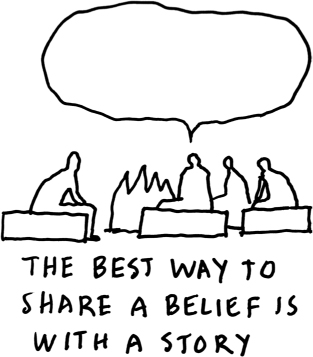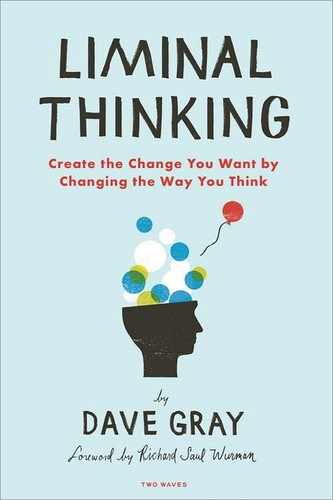PRACTICE
8
Make Sense with Stories
How could you live and have no story to tell?
—Fyodor Dostoyevsky
I was in a taxi with the CEO and the head of sales. It was sort of an accident that I was in the taxi. It just so happened that we were all heading to the airport about the same time.
The executives were deeply involved in a conversation that I wouldn’t have usually heard. I was in the front seat, and they were in the back. They were talking about sales numbers.
It became evident to me that they were explaining the sales numbers to themselves using self-sealing logic. They were simply looking at the numbers and making up stories to explain why the sales weren’t happening.
This guy isn’t stepping up to the plate. That person dropped the ball. This person is incompetent. I knew enough about the situation to realize that these stories they were telling each other were pure fantasy.
I said, “Have you talked to the customer? What about talking to the customer?”
What do you think they said? Do you have a guess?
They didn’t say a thing. They just paused in their conversation, and after a moment they just went right back to their fantasy conversation.
That’s how powerful self-sealing logic is.
This is so common. People ask, “Why isn’t this happening?” and instead of going out and exploring, trying to find valid information, they make up stories.
I’ve been telling a lot of stories in this book. Story after story. Every chapter starts with a story. Why am I telling all these stories?
I started out this book by explaining that a belief is a story in your head. Stories are one of the primary ways we make sense of experiences. To share those experiences later, we tell a story. When people tell stories, they are not just sharing knowledge, but building relationships and expressing beliefs.
Why stories? Facts alone may provide information, but a story gives you context that connects those facts to people, situations, and events. It gives them meaning. Give people facts without a story, and they will create a story to make sense of the facts.
Stories are learning tools. Since language began, a story was the best way to share an experience so that others could learn from it.
In fact, a good story works like a drug, releasing hormones in the brains of the teller and listeners. Brain scans show that when people share stories with each other, their brains connect and mirror each other. Their neurons literally fire in the same pattern in a phenomenon known as neural coupling.
When people hear a stressful, dramatic, high point of a story, their brain releases cortisol, the same hormone that creates the fight-or-flight response and creates strong memories of emotional experiences. And when conflicts or difficulties are resolved, the brain releases oxytocin, the hormone released by physical touch, which creates social bonds and feelings of contentment, calm, and security.1
When someone tells you a story, they are sharing an experience and expressing their beliefs about that experience at the same time. In addition, both teller and listener are pairing their brains, building relationships and creating social cohesion that makes it easier for them to develop shared goals and move toward those goals in a collaborative, coordinated way.

Prompting other people to tell stories, and listening to them, is as much of an art as storytelling. When you ask someone to tell a story, you are telling them that their experiences are important, that they have meaning, and that they matter.
A good way to elicit stories from people is through the use of something called a story prompt. Story prompts are questions about people’s experiences and how they made meaning out of them. Things like:
“Think of the best team you’ve ever been a part of. What happened that made you feel that way?”
“What is the most scared you have ever been? What happened?”
“Tell me about a time when you felt uncomfortable or out of place. What did you do about it?”
“What was your best day at work here, and what made it great?”
“What was your worst day, and what happened that made it so bad?”
“Did you ever have an experience that changed your life? What happened?”
When you ask someone to tell you a story, you are inviting them to deepen their connection with you, to bond with you. It’s an invitation that says their life and experiences are important, meaningful, and worth learning from. It’s a simple step you can take, every day, to create a shared world with the people who matter to you.
Every good story starts with a person in some kind of situation: a problem, a choice, or an opportunity. Then the story tells you what they did, and why, and then it tells you what happened because of that. Maybe a lesson was learned. If the story is good enough, it’s worth remembering and repeating to others.
This makes a story a perfect mechanism for making sense of, and sharing, information. In effect, a story translates facts into “rules for action.” A story is just about the most perfect way to package and share beliefs that you will ever find.
Listen to the stories someone tells, notice the stories they respond to most positively, and you will begin to understand their beliefs—and their bubble.
If you have beliefs that you want to share, beliefs that you think may change the world for the better, the way to help those beliefs take flight is to share them as stories.
PRACTICE 8
Make sense with stories.
If you give people facts without a story, they will explain it within their existing belief system. The best way to promote a new or different belief is not with facts, but with a story.
